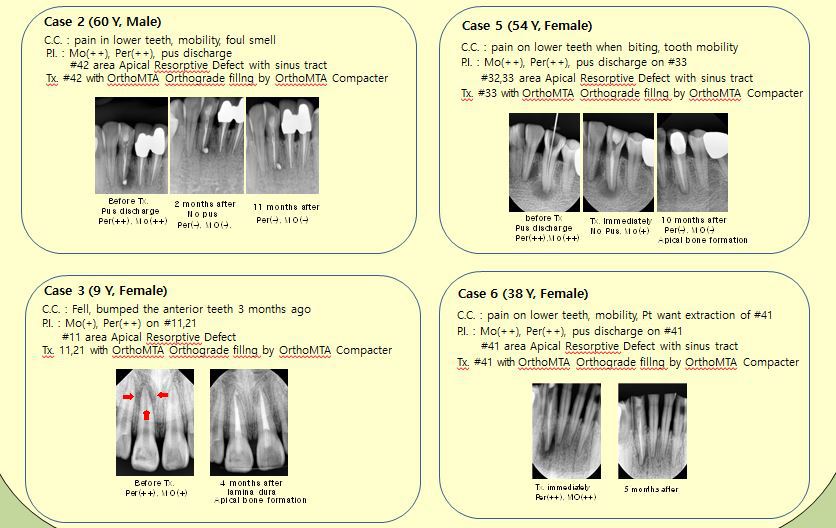IADR Abstract Archives
The Effect of MTA Orthograde Biofilling on Bone Formation on the Previous Periapical Lesion Site
Objectives: Mineral Trioxide aggregate(MTA) has been used in dentistry for more than a decade. An experimental material, MTA has recently been
investigated as a potential alternative restorative material to the presently used materials in endodontics. Several in vitro and in vivo studies have shown that MTA prevents microleakage, is bioactive, and promotes regeneration of the original tissues when it is placed in contact with the dental pulp or periradicular tissues. This poster describes the clinical procedures and outcomes for application of MTA.
Methods: 6 cases in which MTA was used to manage clinical problems were presented. All of the cases have apical resorptive defect. Among the patients with the apical resorptive defect were treated with OrthoMTA (BioMTA Co., SEOUL, KOREA) by orthograde filling by OrthoMTA compacter. The dental records and radiographs were examined only for the patients who had follow-up examination at least 2.5 months after the treatment.
1. Hydration (PBS) & Mixing
2. Making putty-like MTA (W/P ratio 0.33, Remove any excess water by a 4X4 gauze and sterilized cotton swab)
3. Loading (into the OrthoMTA Carrier, gentle tapping motion)
4. Delivery - Premixed OrthoMTA paste is introduced into canal system by the OrthoMTA Carrier
5. Gentle plugging
6. Spreading (with reciprocating motion) & Spacing (0.02 tapered, #25 file)
7. Inserting (OrthoMTA Compacter) & Ready to compact (Withdraw the compacter 0.5 mm from the working length and rotate OrthoMTA Compacter at 60 R.P.M.)
8. Apical 1/3 compaction (by OrthoMTA Compacter, ‘Grasping' sense means formation of the apical plug)
9. Middle 1/3 compaction (by OrthoMTA Compacter up and down, round motion)
10. Coronal 1/3 compaction (by the plugger)
Results: In all cases, OrthoMTA allowed apical bone formation (healing) and elimination of clinical symptoms in a short period of time.
Conclusions: - OrthoMTA cases showed significantly high success rates. It may be because MTA prevents microleakage, is bioactive, and promotes regeneration of the original tissues.
- OrthoMTA in contact with periapical tissue does not affect healing because it allows the growth of the cementum, alveolar bone and periodontal ligament.
- MTA may be an ideal material for certain endodontic procedures.
investigated as a potential alternative restorative material to the presently used materials in endodontics. Several in vitro and in vivo studies have shown that MTA prevents microleakage, is bioactive, and promotes regeneration of the original tissues when it is placed in contact with the dental pulp or periradicular tissues. This poster describes the clinical procedures and outcomes for application of MTA.
Methods: 6 cases in which MTA was used to manage clinical problems were presented. All of the cases have apical resorptive defect. Among the patients with the apical resorptive defect were treated with OrthoMTA (BioMTA Co., SEOUL, KOREA) by orthograde filling by OrthoMTA compacter. The dental records and radiographs were examined only for the patients who had follow-up examination at least 2.5 months after the treatment.
1. Hydration (PBS) & Mixing
2. Making putty-like MTA (W/P ratio 0.33, Remove any excess water by a 4X4 gauze and sterilized cotton swab)
3. Loading (into the OrthoMTA Carrier, gentle tapping motion)
4. Delivery - Premixed OrthoMTA paste is introduced into canal system by the OrthoMTA Carrier
5. Gentle plugging
6. Spreading (with reciprocating motion) & Spacing (0.02 tapered, #25 file)
7. Inserting (OrthoMTA Compacter) & Ready to compact (Withdraw the compacter 0.5 mm from the working length and rotate OrthoMTA Compacter at 60 R.P.M.)
8. Apical 1/3 compaction (by OrthoMTA Compacter, ‘Grasping' sense means formation of the apical plug)
9. Middle 1/3 compaction (by OrthoMTA Compacter up and down, round motion)
10. Coronal 1/3 compaction (by the plugger)
Results: In all cases, OrthoMTA allowed apical bone formation (healing) and elimination of clinical symptoms in a short period of time.
Conclusions: - OrthoMTA cases showed significantly high success rates. It may be because MTA prevents microleakage, is bioactive, and promotes regeneration of the original tissues.
- OrthoMTA in contact with periapical tissue does not affect healing because it allows the growth of the cementum, alveolar bone and periodontal ligament.
- MTA may be an ideal material for certain endodontic procedures.


